
Mathematical ImageryMathematical artists create strong, stunning works in all media and explore the visualization of mathematics
Algorithmic Artwork :: Nathan Selikoff
I love experimenting in the fuzzy overlap between art, mathematics, and programming. The computer is my canvas, and this is algorithmic artwork--a partnership mediated not by the brush or pencil but by the shared language of software. Seeking to extract and visualize the beauty that I glimpse beneath the surface of equations, I create custom interactive programs and use them to explore algorithms, and ultimately to generate artwork.
In the world of chaotic dynamical systems, minute changes in initial conditions produce radically different results. The interface of my software gives me hooks into the algorithms and allows me to exert some control. But there is always tension - between the computer and me, between simplicity and complexity, and between problem solving and spontaneity.
Art and mathematics, the right brain and the left, are inextricably linked in this work. My art depends on mathematics, yet simultaneously illuminates and unravels its beauty. I am an explorer who uncovers something extraordinary, bringing into view that which was always there to be discovered.
— Nathan Selikoff
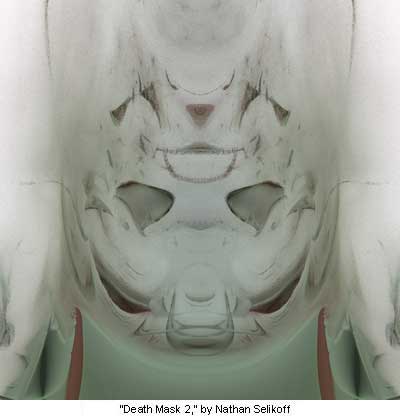
This artwork, from the "Faces of Chaos" series, is a two-dimensional plot of the Lyapunov exponent of a chaotic dynamical system. The Lyapunov exponent is a measure of how chaotic the system is, and in this case, the system is a strange attractor with a four-dimensional phase space. Two of the dimensions are static, and the other two vary in the x and y directions of the image. A custom program renders four 16-bit grayscale images, which represent the different "components" of the spectrum of Lyapunov exponents. These images are combined in Photoshop using a pseudo-color technique to bring out subtle coloration in the final artwork.
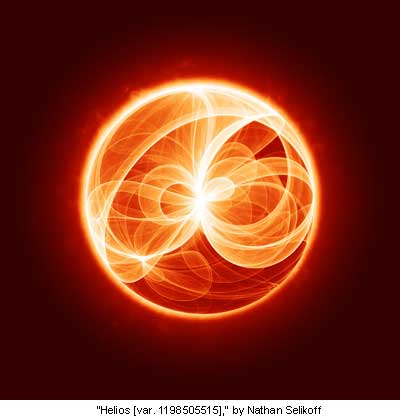
This artwork is based on a rendering of a strange attractor, and is inspired by extreme ultraviolet images of our sun. Helios is part of the Aesthetic Explorations of Attractor Space" series. Underlying each image in this series of work is a two-dimensional plot of the "typical behavior" of a chaotic dynamical system. The number in the artwork title encodes the moment at which the attractor was "discovered" and archived for rendering.
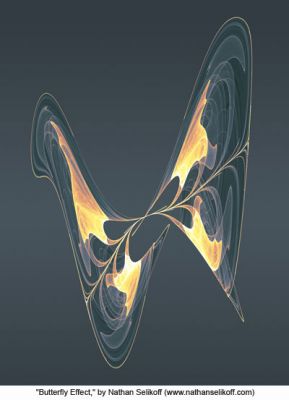
The "Butterfly Effect", or more technically the "sensitive dependence on initial conditions", is the essence of chaos. Besides the fact that this attractor looks like an abstract butterfly, the title of the piece is an homage to Edward Lorenz, a pioneer of chaos theory. It's a quick jump from this popular understanding of chaos theory to playing with the Lorenz Attractor and learning a bit more about the math and science behind it. Read more.
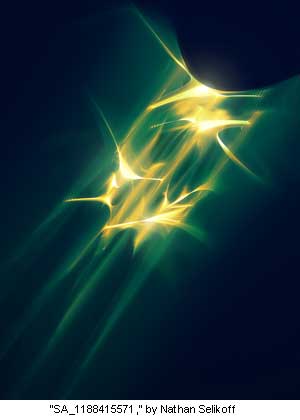
This three-dimensional strange attractor is reminiscent of Hubble images of the Eagle Nebula, though it is a purely mathematical construct.
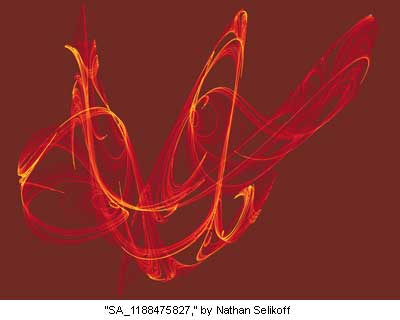
Another strange attractor, this one existing in three dimensions, comes to life with rich fiery colors that enhance the eastern Asian feel of the swirling lines.

What do you see? An owl, spider, space ship? something else? This artwork is a two-dimensional plot of the Lyapunov exponent of a chaotic dynamical system. The Lyapunov exponent is a measure of how chaotic the system is, and in this case, the system is a strange attractor with a four-dimensional phase space. Two of the dimensions are static, and the other two vary in the x and y directions of the image. A custom program renders four 16-bit grayscale images, which represent the different "components" of the spectrum of Lyapunov exponents. Read more.


